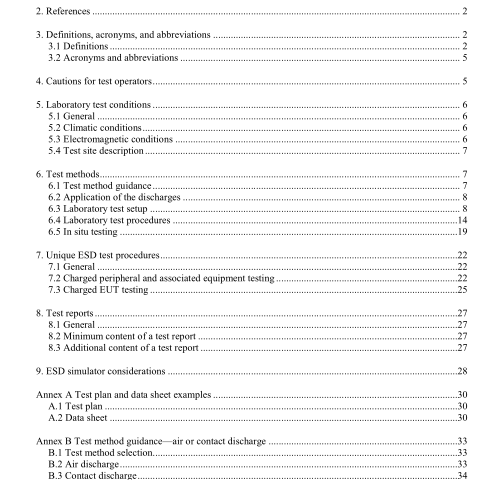IEEE C63.16-2016 pdf download.American National Standard Guide for Electrostatic Discharge Test Methodologies and Acceptance Criteria for Electronic Equipment
This guide provides electrostatic discharge (ESD) test considerations that a manufacturer should use in assessing the expected ESD effects on products in a wide range of environments and customer use.
The focus is well beyond that used to simply show that a product complies with a local, regional, or international standard or regulation. The following are included: charged peripheral testing, connector pin testing, and details on the use of ESD simulators. Finally, suggestions for assuring the safety of those who apply the ESD discharge are provided. The annexes include information on test method selection and more background on air and contact discharge for those who want to further understand the differences in these methods. This guide is not applicable to manufacturing, service, or maintenance of equipment. Personnel who perform these activities should be trained to avoid ESD effects or damage to the equipment.
In summary, this guide has test techniques beyond those that are commonly used (e.g., IEC 61000-4-2), and hence it can be a significant tool for increasing the immunity of products to ESD events.
1.2 Purpose
This guide is intended for use by product manufacturers’ internal or third-party electromagnetic compatibility (EMC) test laboratories that perform ESD immunity tests on products. It is intended to supplement and complement test methods commonly used for demonstrating compliance with ESD requirements such as IEC 61000-4-2. For completeness, the test methods and parameters described herein reference that ESD standard. The complementary test methods provided herein extend the application of ESD testing and can serve as a resource in the development of ESD test plans. This extension of testing requires more time than that needed to perform tests to international ESD standards such as IEC 61000-4-2. The payoff is that this additional ESD investigation is expected to significantly reduce the number of customer complaints by revealing responses that are not found with the usual ESD testing prescribed in existing international standards. This guide also recommends test criteria for applying ESD events and for evaluating equipment exposure and responses to ESD. The actual test levels and acceptable performance depend on criteria set by the equipment manufacturer, which might be based on customer ESD performance experience with the product and the risk of failure in a wide variety of product use environments in which ESD events have different probabilities of occurrence.
2. References
The following references are intended to assist the user of this guide and are listed here because they have direct application to this guide.
The information in each of these standards as applied in this guide is to be considered informative. For all C63 documents referenced in this guide, the latest version applies. For non- C63 documents with no date specified herein, the latest version applies. Regional documents should be checked for any variations from the international standards referenced herein. ANSI C63.14-2014, American National Standard Dictionary of Electromagnetic Compatibility (EMC) including Electromagnetic Environmental Effects (E3).
IEC 61000-4-2, Electromagnetic compatibility (EMC)—Part 4-2: Testing and measurement techniques— Electrostatic discharge immunity test.
3. Definitions, acronyms, and abbreviations
3.1 Definitions
For the purposes of this guide, the following terms and definitions apply. ANSI C63.14 and the IEEE Standards Dictionary Online should be consulted for terms not defined in this clause.
actual ESD events: Non-simulated electrostatic discharges (ESDs) that occur in the intended environment of the electronic equipment.
air discharge method: A method of ESD testing in which the charged electrode of the ESD simulator approaches the equipment under test (EUT) or coupling plane regardless of the conductivity of the ESD receptor.
The discharge is actuated by the dielectric breakdown of the air to the EUT or the coupling plane.IEEE C63.16 pdf download.IEEE C63.16-2016 pdf download
IEEE C63.16-2016 pdf download

Leave a Reply